Pakistan diary: Army controls media
Army says Taliban’s time is up, but with tight media control nothing is transparent.
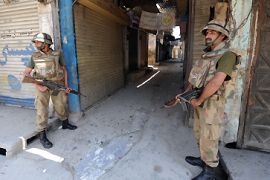
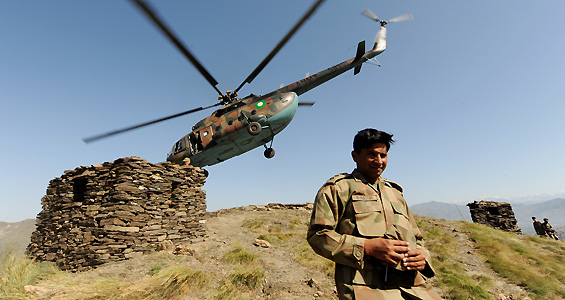 |
| Dawn News is running a 21-part documentary on Pakistan’s army, which is fascinating but at times appears like a promo [AFP] |
Imran Khan, Al Jazeera’s reporter in Pakistan, is filing regular dispatches from the country as the army battles Taliban fighters in the North West Frontier Province.
| Islamabad, Monday, June 8, 13:44GMT |
The news that 400 villagers have bandied together and surrounded Taliban fighters in Dir Province seems to have been welcomed as a sign that the tide is turning against the Taliban.
The villagers mounted the operation after a mosque was attacked in the area.
At a café in Islamabad I sat with two friends as the news came in.
“Good”, said one. “They [the Taliban] deserve it. These people are trying to drag us back to the stone age, and not in a good way like the Flintstones!”
Jokes aside, he was serious in his statement.
It’s becoming more commonplace here – the feeling that the Taliban’s time is up, despite the war dragging on for over a month now. But it’s interesting to watch how Pakistani media is reporting the story.
Message control
One English language channel, Express 24-7, is still flying the flag for Pakistan’s soldiers. Another, Dawn News, is running a 21-part documentary on Pakistan’s army. It’s a fascinating watch, but at times it feels like a promo.
Much of the credit has to go to the way the Pakistani army has handled the media during this crisis. It has denied us access to the warzones, instead relying on briefings to sell their side of the story.
Any charity working in the area had to abide by regulations that it would not take media into conflict areas. All of this has meant that controlling the message has been easy.
There are only a handful of reports on civilian casualties and all of those are based on army figures no one can verify them independently.
Major-General Athar Abbas, an army spokesman, has also sold the army’s message hard to the international news media. As one pundit put it to me: ”He must have been watching the Americans closely.”
I don’t know who he has been watching but one thing is for sure. The army’s message is coming through loud and clear.
| Islamabad, Sunday, June 7, 10:01GMT |
As I arrived on the scene, ambulances were still pulling up.
It would be ironic if it were not so sad: the building that dispatches ambulances now receiving them.
A suicide bomber climbed the wall of Islamabad’s Rescue 15 building and detonated his vest, killing and injuring rescue workers.
The bombing has sent shockwaves through Islamabad.
Not because of the scale – it was relatively small – but because of the type of attack.
The Rescue 15 is a soft security target. The kind of target the Taliban now specialise in.
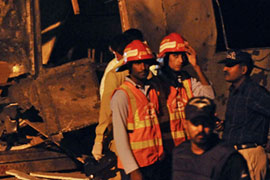 |
| There has been no claim of responsibility for the attack in Islamabad [AFP] |
Although there has been no claim of responsibility, there is no doubt among many here that the Taliban is responsible.
On the scene it was chaos. Journalists, photographers, cameramen all jostling for the best position.
Mingled in with it all were heavily armed Pakistani rangers and police.
Attempting to battle through the melee were ambulance workers trying to get the injured to hospital.
I have now had considerable experience in dealing with the aftermath of suicide bombings.
Peshawar, Lahore, the Marriott, Benazir Bhutto’s return to Karachi. The list goes on.
At every scene the chaos is always the same. The smell of burnt hair and blackened flesh is truly disgusting.
Nothing stood out at the Rescue 15 building.
Nothing was different.
It was a depressing realisation that this is now a regular fact of life here.
But for all the routine, the shock of the bombings stays with me, the shock that it has happened, the shock that it continues to happen.
| Islamabad, Saturday, June 6, 10:51GMT |
Twisted hunks of metal lay strewn across the road.
It’s the result of a brazen raid by the Taliban on a convoy ferrying prisoners into the North West Frontier Province’s main city of Peshawar.
This high profile raid suggests there has been a subtle shift in the Pakistani Taliban’s tactics.
When this war began the Taliban stood their ground and the army had to fight them house-to-house, street-to-street.
Now though, it seems the Taliban have renewed an old tactic: hit-and-run raids.
These raids are incredibly difficult to deal with.
They aim to wear down troops’ morale as constant vigil has to maintained.
The raids often hit low-level target, remote checkposts, supply lines, mobile patrols.
In the case of the Talib’s raid on a prisoner convoy details are still emerging.
But it fits a pattern that has worked so successfully in Iraq, Afghanistan and here in Pakistan.
The raids are, to use a business term, cost-effective. All it takes is a few armed men and some fire power.
Once you have mounted the raids you simply disappear into the background, leaving behind destruction and mayhem.
Because the groups that mount the raids are so small, intelligence on them is difficult to come by.
But the security apparatus can fight back.
In Iraq and Afghanistan, US military humvees have been uparmoured to protect against roadside bombs.
In Pakistan, the army must now decide how they will deal this renewed tactic.
But the army has the technology to protect itself.
Other institutions, however, like the police, are less well protected and are likely to be the Taliban’s targets as this conflict drags on.
| Islamabad, Thursday, June 4, 13:51GMT |
He seemed confident, articulate, and his words hit all the right notes when it came to Islam.
But what did Obama’s speech mean to the people of Pakistan?
I met with a group of young friends, all of them recent graduates from some of the world’s best schools.
These are Pakistan’s educated elite. The kind of people that Obama needs to appeal to if he hopes to sell his message of American change towards the Muslim world.
Nadine Murtaza is a teacher. Her short, bobbed hair and quiet outlook hide a fierce intellect.
“I thought the speech was heartfelt and passionate. But moreover it felt like a long-overdue apology to the Muslim world which I think it was.”
 |
| Obama’s speech did not register with many of Pakistan’s poor [AFP] |
We are watching the speech at the home of one of my friends, Uzair.
He is deciding whether to go to Paris to study international relations.
He was positive about the US president’s words.
“There was a lot of ‘I will, I will’ in his speech and I hope in two years’ time, he goes back to Cairo and makes a speech that says ‘I have, I have’.”
Nosheen Abbas, a columnist, nods in agreement.
But she says the US president has already impacted on the relationship with Pakistan in a positive manner.
“He is the only president who has managed to convince Pakistan that the war against violent extremists is not only a US war, but a Pakistani one as well.”
The fourth friend, Samad Khurram, was cynical, of sorts.
“The speech was not an accurate reflection of the US’ relations with the Muslim world, it was sugar-coated.”
All in all, this group of friends has welcomed the US overture. But perhaps this group would. What about Pakistan’s poor?
Asif is a cab driver. The speech didn’t even register with him.
“I have been running around trying to earn a living, what does Obama mean to me?”
And that solitary statement, perhaps, sums up Pakistan’s relations with the US … some want change, others just want to earn a buck.
| Islamabad,Wednesday, June 3, 10:18GMT |
They say the noose is tightening …
MFU is close to being caught …
For those, like me, who find military speak unfathomable, MFU is Pakistani armyspeak for Mullah Fazlullah.
Fazlullah is the leader of the Swat Valley Pakistani Taliban. The army say they have him in their sights, going on to say: “His death is vital to shatter the myth”.
But I wonder if it is?
Certainly at the moment he is a symbol of resistance. The longer he evades capture or death the more powerful he grows.
But the myth of the Pakistani Taliban is unlikely to die with MFU.
This is a movement with serious traction in parts of the North West Frontier.
Through its use of extortion, violence and religion it has altered the landscape of this country, perhaps forever.
At least 3.4 million displaced people will all remember why they are homeless; the rest of Pakistan understands why they are homeless.
Whatever happens next the Swat valley Taliban has created it’s own myth.
And once this battle is over, other Taliban factions will still be able to strike at Pakistan and hold sway over parts of the frontier.
Killing Fazlullah will be a marker in this conflict. But it won’t mean the end of war or the end of Taliban influence.
As for the myth, my friend, who doesn’t want to be named out of sheer embarrassment, sometimes puts her children to bed with the words “if you don’t go sleep, Mullah Fazlullah will come to get you”.
She laughs when I tell her that’s probably not the best thing for a child’s development and responds by saying:
“I didn’t create the bogeyman, the government did.”
It’s probably not the myth the Taliban or the army were thinking about.
But that’s the thing about myths … they mean different things to different people.
| Peshawar, Tuesday, June 2, 08:25GMT |
After spending Monday with Peshawar’s police and seeing up close the fight against the Taliban, I began to wonder what peace would look like when and if Pakistan’s battle with the armed fighters was over.
There is little doubt here in Pakistan that the army will win militarily.
It may take some time and it will mean moving into other parts of northwest Pakistan, but few doubt it won’t happen.
So let’s say they do win:
Pakistan is at a point where refugees have returned home and the writ of the government is restored.
What then has happened to the Taliban?
One theory runs like this: The main leadership have escaped over the border into Afghanistan and have joined the fight there. Ordinary Taliban fighters have either been killed or have just drifted away from the movement. It is a pease, of sorts That’s a best-case scenario.
Another theory suggests that, as the Taliban has deep tribal roots in the region and a strict Pashtun code of honour, revenge will become its primary concern. To this end, small cells will continue to mount attacks against security forces, and carry out vendettas against those who worked and fought against them.
Some say that’s a likely scenario. Of course, no one knows for sure what will happen, but speculation about what it could look like is rife in Pakistan.
Makes for interesting conversation.
| Arbabtaapu, Pakistan’s tribal areas, Monday, June 1, 11:38 GMT |
The building is dull sand colour, with huge grey bags full of sand at the front. They are called Protective Measures by those in the know, sandbags by the rest of us.
This is the frontline in Pakistan’s other war with the Taliban.
Not the one that is raging in the Swat valley but that is nevertheless keeping Pakistan’s security apparatus busy almost daily.
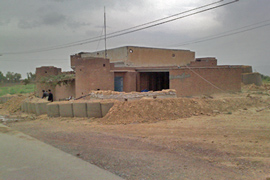 |
| The Arbabtaapu police station sits on the frontline in the war with the Taliban |
Arbabtaapu is a police station. It’s right on the border with Khyber Agency in Pakistan’s tribal areas.
On average it gets hit every two to three days.
The Taliban’s normal tactic is to concentrate fire on one side of the police station and then, when all the focus is turned there, to try and storm the other sides of the building.
The officers here, though, seem to be in good spirits, offering us a refreshing drink of rose and lemon.
We have been brought here by the frontier police, who are under an immense amount of pressure at the moment.
Because of the attacks by the Taliban on the police in the North West Frontier Province, a small but significant number of officers have quit the job, citing personal safety reasons.
Some of the others ones that are left are demoralised and frustrated at the equipment and resources they have.
The region’s top cop, Inspector Malik Naveed, has publicly complained of not having enough to fight back and that his officers go above and beyond the call of duty.
|
|
In the last few years, there have been hundreds of attacks on police stations, and in the last week alone at least six officers have lost their lives.
As the young officers drove us around showing us checkpoints and other scenes of Taliban assaults, I was impressed by their dedication.
They carried AK47 rifles, little ammunition, wore no flak jackets yet saw their duty to protect as above all else.
One of the constables, Irshad Ali Khan was confident when I asked if him if he was ever scared.
“It’s not about being scared. I have to help these people. Fear is not a factor”
Fear may not be a factor, but lack of equipment and resources may well be.
| Islamabad, Sunday, May 31, 07:18 GMT |
A Pakistani defence official has said Pakistan’s battle will be over in two to three days.
Syed Athar Ali’s comments at a security conference in Singapore on Sunday have caused much consternation here in Islamabad.
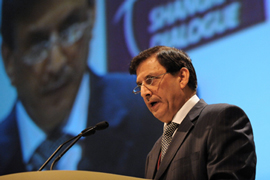 |
| Ali told a Singapore conference that Pakistan’s battle will be over in two to three days [AFP] |
The assessment is seen as “optimistic”.
The Taliban are still fighting back on the outskirts of Mingora. They are still in control, so local sources tell us, of key towns and villages surrounding Swat valley city.
There are still pockets of resistance in the neighbouring area of Buner, where Taliban fighters recently beheaded three men they suspected of spying.
Also, the type of tactics the Taliban are now using are much more in line with classic insurgency warfare.
They are using hit-and-run tactics, spraying machine gunfire at army troops and then retreating.
The army are treating this type of tactic more as a nuisance then a threat, but it shows just how fraught the battle is.
Also if the battle is over within the next three days, then is the war over?
There are now, according to the Pakistani government, 3.4 million people displaced by the fighting.
Making sure they can go home will be an indicator that this war is over. That’s certain to take more than three days.
The defence officials’ comments may, however, have deeper context.
One analyst, retired General Talat Masood, says these comments could be a result of the government wanting to be seen as in control.
“This chap in Singapore has a message and he could be seen as selling the governments side … it’s an optimistic statement,” he said.
Two to three days is, as a another political observer told me, “fighting talk”.
But let’s see – two to three days is a long time in war.
| Islamabad, Friday, May 29, 06:41 GMT |
After a night that has been described as “tragic” and “desperate”, Pakistan wakes once more to the reality of terror.
After four separate attacks, all allegedly linked to the army’s action in the Swat valley, one in particular stands out for me. The attack on Khissakhwani Bazaar.
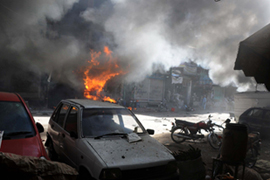 |
| A series of blasts rocked Peshawar on Thursday [AFP] |
On May 15, I visited the Bazaar whose name translates as Storytellers Bazaar.
In ancient Peshawar this was the place artists and thinkers would gather and debate long hours into the night.
It’s still as busy as ever and the day I went, I met with Habibullah Zahid. He was running a charity for Pakistan’s displaced in the middle of the Bazaar.
At the time of writing, I have not been able to make contact with Habibullah.
I am hoping this has more to do with Pakistan’s idiosyncratic telecommunications system rather than any tragic event.
The news of the attacks came in as I was on the road back from covering the bombing in Lahore.
Even for Pakistan, these are trying circumstances. The fears of many about a renewed wave of violence seem to have come true.
What happens next is absolutely crucial.
Al Jazeera is the only news organisation to gain access to the battle in the main town of Mingora.
Shops remain empty with their shutters open, a testament to the haste in which people have left.
But much more than the fighting and the refugee crisis, many are now wondering what happens when the Taliban are on the run from the army?
The root cause that created the Pakistan Taliban still exists. It’s something the Pakistanis have little control over: The War in Afghanistan.
The Afghan Taliban have a lot to fight for and will continue their bloody battle against US and coalition forces.
The Pakistani Taliban are allied to their cause. That means Pakistan is right in the middle.
It was a terrifying night for Pakistan … Storytellers Bazaar has yet another story to tell.
| Lahore, Thursday, May 28, 08:17 GMT |
Lahore comes to terms with another attack on the city.
At the attack site the rangers and the police try and secure the area. The target, seemingly, was the home of Pakistan’s security service.
It is home to many sensitive documents.
As I stood at the scene, the army moved badly damaged computer servers and filing cabinets.
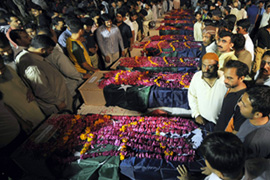 |
| Up to 30 people were killed in the Lahore attack on Wednesday [AFP] |
With this attack the Taliban have upped the ante.
They claimed responsibility for the attack immediately, something they have rarely done in the past.
Their tactic now, according to many analysts here, will be to attack as many of Pakistan’s cities as possible.
By doing so, they will want to put pressure on the Pakistani government to make the war as unpopular as possible, thereby building public pressure on the government to strike some sort deal for a ceasefire.
The government is resolute that it will not bow to pressure.
Ordinary Pakistanis, though, are scared.
In the next few days, markets will be emptier and cafes and restaurants a little less busy.
Lahore will bounce back, it always does. But with every attack, the city that’s famed for an easy going atmosphere will get that little bit more edgy.
| On the road to Lahore, Wednesday, May 27, 06:41 GMT |
I have now been covering Pakistan for a number of years, but today’s attack in Lahore is the thirteenth I have either covered or witnessed.
There was always a fear that Pakistan’s war with the Taliban would spill over into the major cities.
We have seen attacks in the last 10 days in Peshawar, but this attack in Lahore has all the hallmarks of something more organised and more deadly.
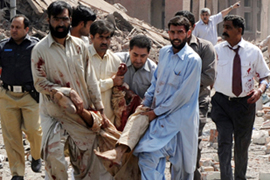 |
| Ordinary Pakistanis now fear the country as a whole is under threat [AFP] |
Lahore is one of Pakistan’s most iconic cities. Known for its liberal attitudes, it is the home of Pakistan’s art and cinema community.
The attack here shows that not only are Pakistan’s security forces under threat, ordinary people are too.
The fear now among many – particularly the friends I have spoken to in Lahore – is that even if the Pakistani army wins the battle for the Swat valley, Pakistan itself will be under threat.
It is worth noting that the Pakistani Taliban, in addition to having a significant presence in the North West Frontier Province, have a reach across the country.
I hope Wednesday’s bombing isn’t the beginning of a new wave of attacks in Pakistan. However, all the indications suggest that is exactly what it is.
|
Sheikh Yassin camp , North West Pakistan, 25 May, 10:45 GMT |
The heat is punishing. It must be 45 degrees C with no wind. A haze seems to rise from every surface.
It’s midday in the camp. Seemingly, there is no escape from the brutal sun.
Children try and cool off by splashing water over each other, which would be a happy scene anywhere else in the world.
Except here.
These children are at risk from dehydration, skin diseases and other problems.
The Swati refugees come from a pleasant and temperate valley, and are used to average temperatures of 25 degrees C.
The refugee camps are on the plains. There is little shade. The refugees are forced to live under canvas; water and food are limited and the toilet facilities are basic.
It’s taking a toll on the people.
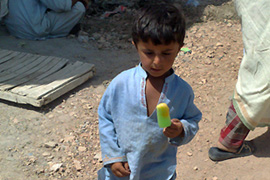 |
| Children are especially at risk of dehydration as the sun beats down on the plain |
Iqbal Ahsan is a rickshaw driver from the main Swat valley town of Mingora.
He heads an extended family of 30. He came to the camp on foot, which took two days. When he got here he was tired and ill, but it was the heat that got him down the most.
“It was unbearable for me. But for my children they suffered more. I had to take them to the doctor. I was scared for them, they were so ill,” he says.
Iqbal’s children have recovered, but his story is common in all the camps.
Doctors have been battling to see as many patients as they can. The risk of diseases spreading is high. Any epidemic would only add to the misery.
Akbar Noor is a medic from the charity Ummah Welfare Foundation. He says he sees 300-500 people a day in the six hours he holds his surgery.
Besides the health problems, Noor faces another issue.
“The medicines we have aren’t sufficient and then the ones we do have are getting spoiled because of the heat. We are trying to build storage facilities but it takes time,” he says.
As I walked down through the camp, the sun was at its highest.
I could feel the sun burning down. I have the luxury of leaving the camp for my hotel. Swatis have no choice but to bear the heat.
|
Jalala refugee camp, 24 May, 09:54 GMT |
As children play with building blocks and shuttlecocks, I feel a sense of peace in this remote corner of Jalala refugee camp. This is a wonderful, safe zone.
It’s run by a Pakistani charity, The Hayat Foundation, and the United Nations Children’s Fund (Unicef).
Just outside the canvas walls of this camp-within-a-camp is a teeming, chaotic refugee city.
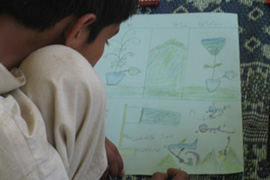 |
| Childrens’ pictures show how deeply the conflict has affected the young [Zein Basravi] |
I am at a “child-friendly space” – Unicef’s term for a nursery.
All the children here been through some sort of psychological trauma. The common cause is separation anxiety.
In the rush to leave the Swat valley, many children simply lost their parents.
They were then taken in by friendly faces or relatives who brought them to the camp.
At the camp they were reunited, but the trauma of being lost took its toll, so much so, that the children here are undergoing assessment by Nabeela Afridi, a psychologist.
“We are seeing post-traumatic stress disorder; children are having nightmares of helicopters and fighter jets [and] they talk about the Taliban constantly,” Afridi says.
I saw the children draw pictures of helicopters flying over houses, and toy soldiers made of plasticine holding guns.
In normal circumstances this would just be innocent play, but the children here are acting out their fears in order to neutralise them. It’s heartbreaking stuff.
One child, Qayanat, is just seven years old. She lost her parents in the rush to leave. She was only reunited with them at the camp.
Her story is common here.
This conflict is having a massive psychological trauma for children and adults alike.
Adults suffer from boredom and frustration in the camps. Boredom because they have been torn from their routines, frustration because they cannot return.
At least in this space, some children are getting some the help they need.
|
Islamabad, Saturday, May 23, 14:07 GMT |
After a night of terror in Peshawar, where another bomb claimed more lives when it exploded in a busy market place, the Pakistani army made good on their promise to enter the Swat valley town of Mingora.
The army were to present the manoeuvre as a success, saying they have captured a key bridge and interchange.
They say they have blown up an explosive laden vehicle and shot a suicide bomber.
So now Pakistan waits.
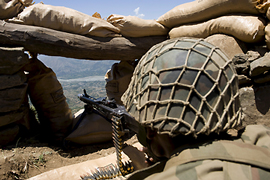 |
| Pakistani troops have moved into Mingora, the main town in the Swat valley [EPA] |
Awaits the outcome of the battle, awaits how it will play out, awaits news of civilian casualties, army deaths and political spin.
This war has united Pakistanis, but for how long?
Rahimullah is a friend of mine from Peshawar. He mourns for his town.
We meet in a television studio in Islamabad, the capital.
“Look at the security here. It’s immense but in my town it’s just not there. We feel exposed. These car bombs and suicide bombers are attacking us. ordinary people”
I ask him what he thinks will happen now fighting has intensified in Mingora.
“More bombs in Peshawar, the Taliban can reach there, They can mingle with the people.
My town is about to become a frontline if thats happens then in good nature we cannot support this fight against the Taliban.”
Frontline Peshawar is a scary thought.
Support for the war is holding but if Peshawar becomes a regular target, then Peshawaris and Pashtuns, the dominate ethnicity in the North West Frontier, may well drop their support for this operation and if that happens then Pakistan’s war will come under immense pressure.
|
Islamabad, Friday, May 22, 13:20 GMT |
It looks like Pakistan’s battle with the Taliban is about to get worse, or to use military-speak, enter a new phase.
The army is making noises about entering the Swat valley’s main town of Mingora.
So far the main thrust of its tactics has been to use heavy artillery and air power to pound Taliban hideouts.
The army insists that it has had to use that kind of tactic to avoid heavy civilian casualties.
In fact, it says the civilian death toll so far in the upper Swat valley is just 10.
 |
| The army says the civilian toll in upper Swat valley is just 10, a figure impossible to verify |
That figure is impossible to independently verify.
In the fight for Mingora though the army will not use heavy artillery and air power.
It is sending in the infantry which will mean house-to-house, street-to-street fighting.
It’s going to be bloody and hard fought.
When I visited Mingora just after the Taliban signed a peace deal, the Taliban were still armed and highly visible as if to say “This is our town”.
Thier confidence is not idle boasting. They know this area well. They know the streets and the best places to hide. This is to be the Taliban’s last stand in the Swat valley.
They have always maintained they will fight to the last man.
The army will take over this town. No one expects the Taliban to fight Pakistan’s well- trained, well-equipped army into submission but the fighters are likely to claim some sort of victory.
We will know what both will say soon enough. Until then Pakistan awaits the outcome with anticipation and fear.
|
Islamabad, Thursday, May 21, 10:01 GMT |
Support for Pakistan’s war seems be to holding. Nightly, the county’s media shows salute its soldiers.
One newspaper headline is particularly striking: “The nation speaks with one voice: Crush ’em!”
 |
| Pakistan will have to deal decisively with the massive refugee crisis it faces as a result of the conflict [AFP] |
In the markets and coffee shops people seem to want the crisis over, but welcome the fact that the army is tackling the Taliban.
“The thing is, Pakistanis have realised that the Taliban have gone back on their promises, have shown themselves incapable of sticking to peace deals so Pakistanis have become fed up,” Khadim Hussien, a university professor and analyst, told Al Jazeera.
“The Taliban are offering nothing – no new ideas, no way out.”
It’s an interesting thing to witness, this broad public and political support for the war.
Just a few months ago the government was under immense pressure because its military action against the Taliban in the Swat valley was being vocally criticised.
The army, fearful that their image would be tarnished, supported a landmark peace deal brokered by a pro-Taliban cleric between the provincial government of the North West Frontier Province and the Taliban.
| In video |
|
|
As we now know, that failed.
The Taliban moved into Buner and Dir districts and Islamabad was forced to act.
This latest operation is said to be a decisive action against the Taliban to finish them once and for all.
But beyond that task, challenging as it is, are others.
To maintain support for the war, Pakistan has to deal decisively with the massive refugee crisis it now faces.
It needs to show that the operation is Pakistani by design and that no foreign pressure has been put on the country.
If Pakistan’s politicians can keep all those plates spinning, then perhaps Pakistanis will keep supporting the war.
But as the refugee crisis mounts and more soldiers die, the odds are stacked against Islamabad.
|
Mirabadi Village, Wednesday, May 20, 07:40 GMT |
The vast majority of Pakistan’s almost 1.5 million refugees are living outside of the camps in private accommodation.
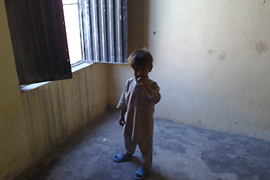 |
| Mirabadi Village, which lies just outside of Islamabad, is a ‘slum village’ |
We visited some of these people to really see what their living conditions were like and to hear their stories.
The term “private accommodation” conjures up images of families helping each other out, living in nice conditions with a homely atmosphere.
Whilst that might be true for some, for others the living conditions are as challenging as those in the camps.
Mirabadi Village – just outside of Islamabad – is a slum village. It’s dusty, with narrow cobbled streets, open sewers and poor house workers. The type, although not Pakistan’s poorest, that have little.
But even here amongst the heat and barefoot children are stories of incredible generosity.
Nazimuddin is a labourer, working whenever he can find a job carrying bricks in one of the capital’s many construction sites.
If he earns a dollar a day he considers himself lucky.
His house is basic, two rooms and toilet, with an outdoor cooking area.
Crucially, however, he has a basic house next door in his village which was empty.
A Pakistani charity, FHRO, based in Swat asked him if he could house refugees.
He jumped at the chance to help.
“I have no television, radio, but the villagers her were talking about the fighting in Swat, I knew I had to help,” he says.
“It is my duty as a Muslim, as a Pakistani. I have very little.”
It has made a massive difference to Ahsanullah who lives in the house.
They have few facilities. Pakistan’s energy crisis means they are without electricity, they use gas to cook with, but even then the cost of gas means the have to use it sparingly.
Ahsanullah fled with his familiy and were placed here by the charity.
“This man has very little, but what he does have he shares with us,” he tells me.
Ahsanullah and Nazimuddin are now firm friends. As their children play together I can’t help but be struck by just how, in the face of a massive crisis, Pakistanis have united and continue to unite.
| Islamabad, Tuesday, May 19, 13:13 GMT |
After careering around the North West Frontier Province for the past week or so, it feels good to be back in the relative calm of the capital Islamabad.
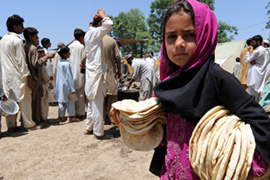 |
| The government assault on pro-Taliban fighters has forced 1.5m to flee their homes [AFP] |
I say relative calm because, despite the fact that I was here just a few weeks ago, I have noticed a few changes.
Huge concrete walls have gone up around some buildings. In other parts, black and yellow concrete safety barriers have turned open roads into go-kart courses.
The Marriott Hotel, subject to a massive bomb blast in September last year, is cocooned in a massive shell made out of blast walls and sandbags.
Armed guards, pump action shotguns draped casually over their shoulders, stand on every street.
This is Fortress Islamabad.
It’s been like this for a while now, but in last few months security the capital has gone into security overdrive.
Driving past the Parliament requires you to navigate several checkpoints and the route from one end of Islamabad to the other, which used to take 20 minutes, can now take an hour.
I contrast this with the Islamabad of my youth. My younger brother, sister and I used to come to the capital city on holiday as children.
In the 1980s it was nice place. Families would picnic in the hills that surround the city, you could go horse riding, every available space seemed to taken up by young men playing cricket and groups of girls would sit in cafes sharing ice cream and gossip.
The only security you would see was on the outskirts of the city. You would have never seen Pakistani army soldiers ensconced in sand bag posts.
That peaceful Islamabad seems to have gone.
Don’t get me wrong, Islamabad still continues in it’s own way, but as city it has changed irrevocably.
Fashion shows still happen here, there is a thriving arts scene, the markets are packed with every kind of Pakistani buying every kind of cloth and the cafes are still doing a brisk trade.
But it’s not the carefree atmosphere of my youth. People tend not to hang around as much as they used to, most entertaining now happens at home and Islamabad’s vast array of restaurants, though packed by day, remain emptier than ever at night.
Islamabad – they call it the beautiful city here. Carved out of the hills it’s definitely that, but it’s also nervy and tense.
| Mardan, Monday, May 18, 12:03 GMT |
At every corner, on every road, it seems someone is trying to raise money, ask for goods, or pray for Pakistan’s displaced.
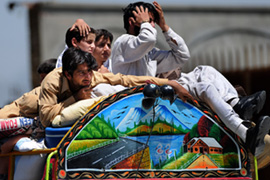 |
| The outpouring of charitable aid has been ‘extraordinary’, says Imran Khan [AFP] |
Mixed in amongst it all is a small stall with a black and white flag gently fluttering away.
The flag is a surprise to me as it belongs to a group that was banned: Jamaat Ud Dawa.
The UN put them on a terrorist watch list after the Mumbai attacks last year.
The group then disappeared as it members were arrested. Now here they are, working alongside the UN.
The group seems to have risen from the ashes.
But there is a new name to describe it: Falah-e-Insaniat Foundation, which translates as the Humanitarian Welfare Organisation.
I asked the spokesman, a young bearded chap with and high visibility orange jacket on, if the name change was simply cosmetic. He was non-committal.
“We coordinate with Jamaat Ud Dawa, but we co-ordinate with several charities,” he said.
Inside the tent sat Yayha Mujahadin, a key member of Jamaat Ud Dawa. I asked him for an interview but he declined.
It seems whoever this particular group is, they are keeping a low profile.
For the people in the camp, though, it matters little who is supporting them, whether it’s groups with alleged links to jihadist organisations, the UN, or student organisations – the aid is important.
The vast majority of Pakistans estimated 1.5 million refugees live with family or friends but a significant chunk live in camps which are supplied by Pakistanis of every political hue.
It is extraordinary, the outpouring of generosity I have witnessed over the last week.
But what will stick with me is the sight of a member of a group the UN has put on terrorist watch list work alongside the UN when it comes to helping refugees.
| Peshawar, Sunday, May 17, 14:09 GMT |
It has been a very eerie day in Peshawar.
After Saturday’s bomb blasts – which killed at least 11 people and wounded several others – Pakistan has had time to digest the events.
Pakistani politicians seem to have taken a bullish stance. They want to get rid of the Taliban.
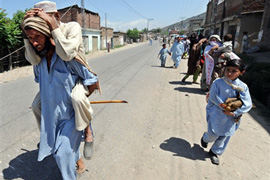 |
| Pakistan is braced for what could be a decisive assault on the Swat town of Mingora [AFP] |
The chief minister of the North West Frontier Province says he wants the army to go after the Taliban in other areas of the country.
He has some support for the idea, but others are fearful over any more military action.
With something like 1.5 million Pakistanis already displaced, any additional military action is likely to cause that figure to skyrocket. Pakistan is struggling to cope with the problem it has, never mind any more.
Also, ordinary Pakistanis are terrified of reprisal attacks. The Taliban are said to have several bases across Pakistan from which they can launch attacks.
It is a very tense situation.
The government, though, seems to be sensing victory.
Pakistan is braced for what could be a decisive assault on the main Swat town of Mingora.
The Taliban have said it’s victory or death.
Whatever the outcome, what is clear is that Swat valley is only the beginning of Pakistan’s fight.
The Taliban are unlikely to just give up Swat without attacking major cities.
The government may be confident of victory, but Pakistanis are terrified of at what cost it will come.
| Peshawar, Saturday, May 16, 12:44 GMT |
Another shocking day for Pakistan.
This time it’s not in the Swat valley but here in the city of Peshawar.
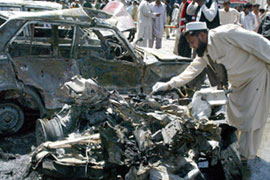 |
| The car bomb exploded outside an internet cafe in the city of Peshawar [EPA] |
It was little after midday when a car bomb exploded outside of an internet cafe killing and wounding many, including several schoolchildren waiting in a nearby bus.
More innocent victims of Pakistan’s battle within.
I was on the phone with a Peshawari friend when the news came in.
His reaction was telling.
“Imran, I have to leave this country. I have to get out. What on earth is going on?”
My friend Yousef is the future of this country. Young, educated and articulate he is exactly the kind of person to drive things forward.
But he, and many others, no longer feel safe in Pakistan.
Anecdotal evidence suggests that many young Pakistanis are leaving.
I was in Dubai in March and what struck me most was the amount of young Pakistani nationals who had settled there.
The situation is much the same in Britain and the US.
As news of the Peshawar car bomb continued to come in, I called Yousef back and asked him whether he would really leave.
“My uncle works in Washington as a political lobbyist. He says his firm needs people who understand the US and Pakistan. What would you do?”
I understand that Yousef is beginning to feel like he has little choice but to leave. I only hope Pakistan will one day tempt him back.
| Peshawar, Friday, May 15, 13:47 GMT |
One of the great things about Peshawar is its history. Behind its noisy, congested streets lie alleyways and markets that have stood for centuries. One such place is Storytellers Bazaar.
In days gone by, this was where artists, poets and thinkers would gather to sing, argue and swap stories late into the night.
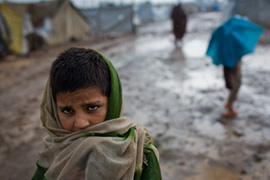 |
| Thousands of charities have sprung up in response to the crisis [GALLO/GETTY] |
I have come here because another song is now being sung, a lament for Pakistan’s displaced – refugees in their own country.
Here one of thousands of charitable organisations has set up a stall gathering together vital food aid, money and supplies to ship to the camps where hundreds of thousands now live.
The stall is surrounded by electric fans. Stacks of rice are piled high and small denomination currency is strewn across a ramshackle wooden table.
The stall is run by Habibullah Zahid, a large, jolly, bearded man who runs restaurants by day and the charity by night.
I asked him what on earth refugees living in tents would do with electric fans.
“They need these desperately,” he said.
“Those camps will get electricity eventually. You have to remember that these people are used to the cooler climes of the Swat Valley. This is [a] hot place. You will see these will be most useful.”
Whatever Pakistanis feel about the military operation, the humanitarian crisis has united them.
Newspapers are full of advertisements urging readers to donate, television commercials run on loop showing heartbreaking images of children and the elderly.
As I talked to him, people drop money onto Habibullah’s table. Some of Pakistan’s poorest people, are donating as much money as they can to stalls such as these all over the country.
Their generosity is humbling.
As Habibullah and I talk, a small boy – he must be seven or so years old – begins to sing and a crowd quickly gathers.
His voice rises as more people watch; his words capture the crowd’s attention.
I later find out that he is singing the poetry of Sufi Rehman Baba, a 17th century mystic more commonly known around here as the “Nightingale of Peshawar”.
The boy’s choice of song is particularly poignant. A few months ago Sufi Rehman Baba’s shrine, which has stood since he died in the 17th century, was attacked by men claiming to be Taliban fighters.
They planted four devices to try to destroy the shrine, but it survived.
When this chapter in Pakistan’s history closes, perhaps it will be remembered and re-told by the storytellers in Peshawar.
Perhaps people will wonder how such a thing ever came to pass.
| Swabi, North West Frontier Province, Thursday, May 14, 12:22 GMT |
The first thing that hits you when you visit a refugee camp is the sheer scale.
“Camp” is too small a word to use- these are cities of canvas and rope.
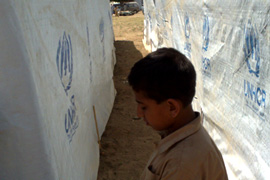 |
| Yar Hussein is home to 4,000 refugees, much smaller than the 48,000 strong Jallala camp |
Yar Hussein camp has only been running for a few days. So far it houses 4000 refugees – a small town compared to say Jallala refugee encampment which has upwards of 48,000 people living there.
But nonetheless housing people is a mammoth task.
Getting these tents up, supplying water and food is a logistics nightmare.
I spoke to the cook at the camp. He told me: “We are doing the best we can, but look at what we have.”
He pointed to huge cauldrons bubbling away, cooking rice. The pots had definitely seen better days.
His whole open air kitchen reminded me of a wedding I had been to in Pakistan as a child – the fires roasting, the multi-coloured awning covering the kitchen area.
This, though, was far from a celebration. It is a “massive crisis” – according to Antonio Guterres, the United Nations high commissioner for refugees.
A soft-spoken man, he is visiting the crisis area for the first time and has passionately pleaded for the world to take notice.
“Pakistan has hosted the largest refugee population in the world – 5 million Afghans – Pakistan now needs help itself and the world must pay attention.”
The UN and other aid agencies have a big job on their hands.
This is the biggest movement of people in recent times. The figures are worth going over again.
At least 1.3 million people are on the move and more than 800,000 are registered with the UN alone as refugees.
But behind that figure lies another one. You could call them the forgotten refugees.
Since August 2008, people have been fleeing clashes across the North West Frontier Province. The army has been battling Taliban fighters and more than 500,000 refugees have been registered in camps by the UN since August last year.
They have been living makeshift accommodation since then. The Red Cross has registered another 400,000.
These figures are mind boggling.
I had a chance to reflect on the numbers while I was in the camp. Watching children roam freely, playing as they do, I found myself wondering how many of them would spend their formative years living in places like these.
When so many people live together disease also becomes a problem. Cases of diarrhoea and skin problems have already been registered.
I wonder how many of the children I saw will survive.
| Peshawar, Wednesday, May 13, 06:43 GMT |
The army is really selling its side of the story.
On Tuesday, it proudly told the media that it had managed to capture a key Taliban stronghold, Gatt Pachar.
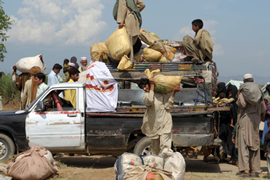 |
| The humanitarian crisis persists as thousands of families are displaced by fighting [AFP] |
This mountain is the base of Mullah Fazlullah, the leader of the Pakistani Taliban.
It is said to house armed fighters, training camps and arms dumps.
Capturing it was key.
But has it made a difference?
Well, yes and no. Denying the Taliban any ground is crucial. But were key Taliban leaders there at the time?
It would appear not. That’s an issue.
The longer Mullah Fazlullah evades capture, the more of a totem he becomes, and a symbol for the Taliban fighters.
That gives him strength and power beyond his tactical skills.
Speculation suggests that Fazlullah remains in the Swat valley. Sources close to the Taliban have told Al Jazeera that Fazlullah knew that the army would target his base and that, by leaving fighters there, he was able to escape along with the senior leadership.
That’s important because the Taliban has plenty of fighters, but what the group lacks is men with military knowledge to guide them.
Experts say the Taliban’s senior leaders have that knowledge, which encompasses guerrilla warfare, bombmaking and other skills.
If Mullah Fazlullah and men such as his senior commander Ibn-e-Amin perish, then the army can say the Taliban has been defeated.
So far, the Taliban insists that its leaders are all still alive and battle goes on.
So, while the army sells its message of success, success, success others are less sure.
The humanitarian crisis continues; so far, the government says 1.3 million have been displaced. Ordinary Pakistanis are watching the pictures on their television screens nightly and wondering how on earth this spells peace.
| Peshawar, Tuesday, May 12, 2009, 09:22 GMT |
Peshawar is a town with a past littered with the ghosts of war.
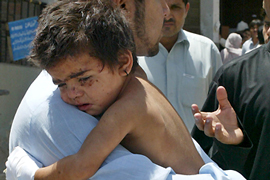 |
| A palpable fear now hangs over the city after frequent deadly attacks [EPA] |
Traditionally it has inhabited the crossroads between Pakistan and Afghanistan.
It was here the British Empire headquartered its great game against Russia in the 19th century.
It is here that the Afghan mujahidin gathered logistics to fight their war against Russian occupation in the 1980s.
This dusty town with its cobbled alleyways was the place where CIA agents mingled with their Pakistani counterparts to conduct their war in Afghanistan after the twin towers in New York fell.
And now Peshawar is once again at the centre of conflict.
It’s already home to thousands of refugees fleeing those wars in Afghanistan.
But this time its war is raging within Pakistan’s borders and those refugees are Pakistani.
It’s had an incredible effect on Pakistan.
The media here have dubbed this the biggest movement of people since partition, when millions crossed the new border between Pakistan and India in 1947.
|
“The media here have dubbed this the biggest movement of people since partition… in 1947” |
Ordinary Pakistanis have taken to the streets demanding the fighting stops.
One taxi driver told me he fears the break-up of Pakistan.
Another shop owner in one of Peshawar’s hotels says war will only make the situation worse, that the Taliban will hide in the mountains and fight until the bitter end.
The bitter end.
It’s worth thinking about how exactly Pakistan will end its military operation.
The government wants a swift operation that will allow them to claim victory.
Analysts say the army wants to be able to secure the area quickly and withdraw leaving the police in charge.
At the time of writing, the end is nowhere in sight.
The only thing we can say with any degree of certainty is that Pakistanis will flood into the camps and the battle still rages.


 Inside Swat’s conflict zone
Inside Swat’s conflict zone